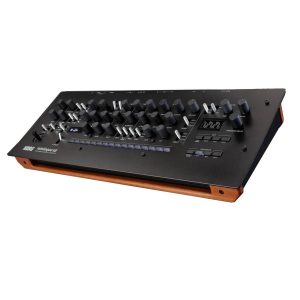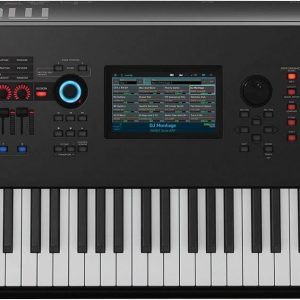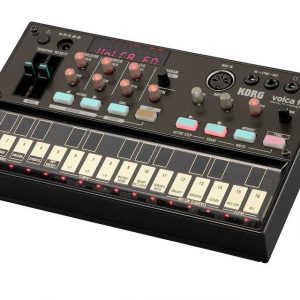Behringer K-2
$228.99
Get the best of both worlds with the Behringer K-2: a unique, hybrid synthesizer that brings together the power of synths and drum machines for a truly unique sound.
Compare
Description
Behringer has been releasing a steady stream of affordable, feature-rich synthesizers in recent years, and the K-2 is one of their most exciting offerings yet. This monophonic analog synthesizer is based on the classic Korg MS-20, a legendary synth from the 1970s that has been used by countless musicians for its unique and versatile sound.
The K-2 is a faithful reproduction of the original MS-20, with a few modern updates and enhancements. It has the same dual-oscillator design, with a range of waveforms and sweepable filters that allow for a wide range of sounds. There are also two envelopes, a sample-and-hold oscillator, and a modulation-generator that can be used to create complex and evolving sounds.
One of the biggest advantages of the K-2 over the original MS-20 is its added MIDI functionality. The K-2 has MIDI in, out, and through ports, as well as USB connectivity, which make it much easier to integrate into a modern studio setup. It also has a built-in sequencer and arpeggiator, which can be used to create complex and intricate patterns.
Another great feature of the K-2 is its patchbay, which allows for a high degree of customization and experimentation. The patchbay has 16 inputs and 16 outputs, which can be used to connect to other modular gear or to create complex signal flows within the synth itself. The patchbay also includes a wide range of patchable controls, including the filter, oscillator frequency, and pulse-width modulation.
Overall, the Behringer K-2 is a fantastic synthesizer that offers a lot of value for its relatively low price point. Its faithful reproduction of the classic Korg MS-20 sound, combined with modern conveniences like MIDI and a patchbay, make it a great choice for both beginner and experienced synth enthusiasts. Whether you’re looking to create classic analog sounds or explore new sonic territory, the K-2 is a must-have addition to any synth collection.
Behringer K-2 properties
| Product name |
K-2 |
| Brand |
Behringer |
| Type |
Keyboard Instruments |
| Keyboard Instrument |
Synthesizer |
| Key Functions |
Touch Sensitive |
| Rotary Controls |
Yes |
| Connections |
6.3mm (1/4″RTS), Headphone, MIDI, MIDI In, MIDI Thru |
| Colour |
Black |
| Power Supply |
Electrical Cable to Wall Socket |
Frequently Asked Questions:
What are some basic steps to get started using the Behringer K-2 synthesizer as a beginner?
Here are some basic steps to get started using the Behringer K-2 synthesizer as a beginner:
1. Familiarize yourself with the layout of the instrument: The K-2 is a simple, analog synthesizer that has several knobs and buttons for controlling sound. Take some time to familiarize yourself with where everything is located on the device.
2. Plug in your headphones or speakers: Before you can start playing, make sure you have connected your headphones or speakers to the output jack on the back of the K-2.
3. Set the power switch and MIDI mode: Turn the power switch to "ON" and set the MIDI mode to "Off". This will ensure that any sounds produced are generated by the K-2 itself rather than being triggered from an external source.
4. Adjust the volume knob: Locate the volume knob on the front of the synthesizer and turn it clockwise until you reach a comfortable listening level.
5. Explore the oscillators: The K-2 has two oscillators, Oscillator 1 (OSC1) and Oscillator 2 (OSC2). These generate the basic sounds of the synthesizer. Start by adjusting the frequency knobs for each oscillator to find interesting sound combinations.
6. Experiment with filters: The K-2 has a low-pass filter that can be adjusted using the "CUTOFF" and "RESONANCE" knobs. Try experimenting with different settings to create different sounds.
7. Use the LFO (Low Frequency Oscillator): The LFO is used to modulate various parameters of the synthesizer, such as pitch or filter cutoff. Adjust the LFO rate and waveform to find interesting effects.
8. Add some reverb: The K-2 has a built-in reverb effect that can be activated by turning the "REV" knob clockwise. This will add more depth and space to your sounds.
9. Connect external devices (optional): If you want to connect additional devices such as MIDI controllers or pedals, refer to the manual for instructions on how to do so.
10. Start creating music: Now that you've familiarized yourself with the basics of the K-2, it's time to start creating your own music! Experiment with different settings and techniques to find what works best for you.
What are the recommended maintenance procedures for prolonging the lifespan of a Behringer K-2 synthesizer module?
To ensure optimal performance and extend the lifespan of your Behringer K-2 synthesizer module, we recommend the following maintenance procedures:
1. Keep the module clean: Use a soft cloth to wipe down the front panel and connections regularly to prevent dust and dirt accumulation. Avoid using harsh chemicals or solvents that could damage the surface finish. Store it properly: When not in use, store the K-2 in a dry place with stable temperature and humidity levels. Avoid exposing it to extreme temperatures, moisture, or direct sunlight. Use the manufacturer's provided carrying case if available. Check connections: Before using the K-2, make sure all connections are securely fastened and properly aligned. Loose or misaligned connections could cause electrical shorts or signal interference. Adjust the calibration: The K-2 may require occasional calibration to ensure accurate frequency response. Follow the manufacturer's instructions for performing this process. Avoid overloading: To prevent damage to the module, do not exceed its input and output limits. Overloading could result in distortion or damage to the internal components. Use a power conditioner: If you are using multiple synthesizer modules, consider using a power conditioner to regulate the voltage and eliminate power surges that could affect their performance or lifespan. Get it serviced: If you notice any issues with the K-2's performance or functionality, have it inspected by a qualified technician. Prompt repairs or servicing can prevent further damage and prolong its lifespan. By following these maintenance procedures, you can ensure that your Behringer K-2 synthesizer module performs optimally for many years to come.
How does the Behringer K-2 synthesizer's analog modeling technology compare to traditional analog synths in terms of sound quality and versatility?
While traditional analog synthesizers offer a unique and distinct sound that has been favored by musicians for decades, the Behringer K-2 synthesizer's analog modeling technology provides an alternative option with its own set of advantages. The K-2 uses advanced digital processing to accurately replicate the behavior of classic analog oscillators, filters, amplifiers, and other components, resulting in a sound that is virtually indistinguishable from that of their analog counterparts. This means that the K-2 can deliver the same rich, warm, and complex sounds that are synonymous with traditional analog synthesizers. In terms of versatility, the Behringer K-2's digital nature allows for more extensive editing capabilities than what is possible on a purely analog device. It offers a wider range of parameters to manipulate, enabling users to create a greater variety of sounds and textures that may not have been achievable with a traditional analog setup. Additionally, the K-2 comes equipped with a user-friendly interface, making it more accessible to musicians who are new to synthesis or those who prefer a digital workflow over an analog one. Ultimately, whether you prefer the sound and feel of traditional analog synths or the flexibility and convenience of digital modeling is a matter of personal preference. Both approaches have their own unique benefits and drawbacks, and it's worth exploring both options to determine which best fits your needs as a musician.
How does the Behringer K-2 synth's advanced analog filter design contribute to its distinctive sound and versatility in music production?
The Behringer K-2 synth's advanced analog filter design sets it apart from other digital synthesizers on the market. The multimode filter allows for a wide range of tonal shaping options, including low pass, high pass, band pass, and notch. This versatility gives musicians and producers the ability to create unique and distinctive sounds that cannot be achieved with standard digital filters. Additionally, the analog filter design adds warmth and character to the synth's output, making it a popular choice for those looking to infuse their productions with an organic and authentic sound. Overall, the advanced analog filter design on the Behringer K-2 synth is a key factor in its distinctive sound and versatility in music production.
What is the primary difference between the analog oscillators used in the Behringer K-2 and those found in its digital counterparts, such as the DDX3216?
The primary difference lies in their architecture and functionality. Analog oscillators are based on traditional electronic circuits and rely on physical components like transistors, diodes, and capacitors to generate sound waves. These circuits are inherently analog in nature, allowing for a rich, warm, and often "musical" tone that many producers and musicians find desirable. On the other hand, digital oscillators used in devices like the DDX3216 rely on complex algorithms to produce sound waves. They use numerical methods to calculate the output signal, which results in a more precise control over the frequency and waveform but can also lead to a "cold" or "sterile" sound if not properly programmed. In terms of sound quality, analog oscillators tend to introduce subtle imperfections and variations that many musicians believe are essential characteristics of their tone. These include things like harmonic distortion, thermal noise, and other forms of non-linearity. Digital oscillators can be designed to mimic these behaviors, but they often lack the organic feel of true analog circuits. In practical terms, this means that if you're looking for a warm, rich sound with a lot of character, an analog oscillator like those found in the Behringer K-2 might be a better choice. However, if you need precise control over your sounds and can live with a more neutral tone, digital oscillators could be a good option.
Before you buy Behringer K-2








Reviews
There are no reviews yet.